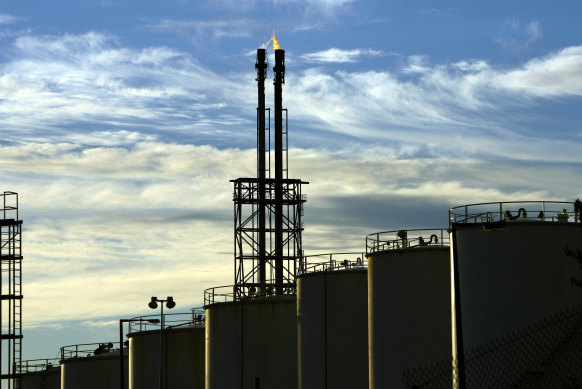By Nick Toscano
One of Australia’s biggest fuel suppliers says there is growing recognition that time is running out to stop crippling gas shortages hitting homes and businesses in the nation’s south-east as it prepares to resubmit a bid for approval to start importing liquefied gas into Geelong.
Rapid declines from the giant offshore gas fields in Bass Strait have intensified warnings that supplies are tightening in Victoria, NSW, South Australia and Tasmania during winter and could be in deficit by 2028, raising the risk of gas shortages and runaway energy bills.

Viva Energy, owner of the Geelong oil refinery, is seeking approval to begin importing liquefied natural gas into Victoria for the first time.Credit: Nic Walker
Australia is one of the world’s top shippers of liquefied natural gas (LNG), but large volumes of Queensland production are locked into long-term export contracts, while pipeline limitations restrict how much gas can flow south on days of heavy demand and gas from WA cannot be transported east.
Viva Energy, which owns the Geelong oil refinery and the national Shell and Liberty petrol station chains, said on Monday it was close to resubmitting its environmental studies to extend a refinery pier in Corio Bay to park a vessel capable of receiving LNG cargoes from other parts of Australia or overseas and turn it back into vapour.
The project was initially planned to start delivering gas by the winter of 2024, but a final investment decision was pushed back amid a drawn-out environmental approvals process and requests from the state government for additional information on its potential local impacts.
“We have largely completed the additional studies that we sought as part of the environmental approval process, and we are very close to being able to restart the process,” Viva chief executive Scott Wyatt said.
If the Victorian approval process concluded by the end of the year or early 2025, he added, Viva was confident it could sign necessary commercial deals with gas retailers or industrial buyers to underpin the investment, and could start delivering gas to the market by “mid-2028” – in time to help ease the threat of shortfalls.
“That’s the timing we are working to at the moment,” Wyatt said. “A lot of that depends on how long the environmental approval process now takes.”
The last time Viva Energy’s proposed terminal was submitted for permitting, it met strong resistance from environmentalists and some community members, who argued it was too close to residential areas and schools, and feared it would set back Australia’s climate ambitions by entrenching the use of harmful fossil fuels. In 2022, the Victorian government said Viva would be required to submit further information on the environmental impact.
Wyatt on Monday expressed confidence it could clear environmental hurdles when it is put out for public consultation again.
With gas shortfalls approaching and the long lead time it typically takes to develop new gas production fields, Wyatt said an LNG import terminal was among the only options left for Victoria to avert an energy crisis.
“There is an increasing recognition that we need to get on with it,” he said.
Another project in NSW, which is being built by billionaires Andrew and Nicola Forrest’s Squadron Energy, is looming as Australia’s first LNG import facility. Construction of the Port Kembla LNG terminal is nearly 100 per cent complete, but is yet to sign long-term offtake agreements with potential customers.
The update on Viva Energy’s Geelong LNG proposal came as the ASX-listed company reported a 10 per cent lift in underlying half-year profit to $192 million, while overall fuel sales rose 6 per cent to 8.3 billion litres. Convenience store sales slipped over the period as consumers continued battling cost-of-living pressures.
Barrenjoey analyst Dale Koenders said service station sales were expected to pick up in the second half, but oil refining margins – the spread between the price of refined fuels and the cost of crude oil inputs – remained weak due to recessionary fears, and were likely to weigh on the refinery’s outlook.
After sealing a deal to buy the OTR petrol station chain from the Adelaide-based Peregrine Corporation, Viva is in the process of converting its Reddy Express stores to successful OTR retail offerings, which include quick-serve restaurants and groceries, and are expected to become increasingly important as drivers spend longer periods waiting for their electric vehicles to charge.
Excluding South Australia, each OTR store is generating on average $2.5 million in convenience sales a year, compared to $1.6 million at Express stores, the company said.
UBS analyst Tom Allen described Viva Energy’s half-year result as solid, with the interim dividend at the top end of its policy, and the rollout of OTR sites progressing well.
Viva’s shares were expected to trade positively on the “better-than-expected” integration update and growth outlook, Allen said, and ended the day trading 0.7 per cent higher.
The Business Briefing newsletter delivers major stories, exclusive coverage and expert opinion. Sign up to get it every weekday morning.